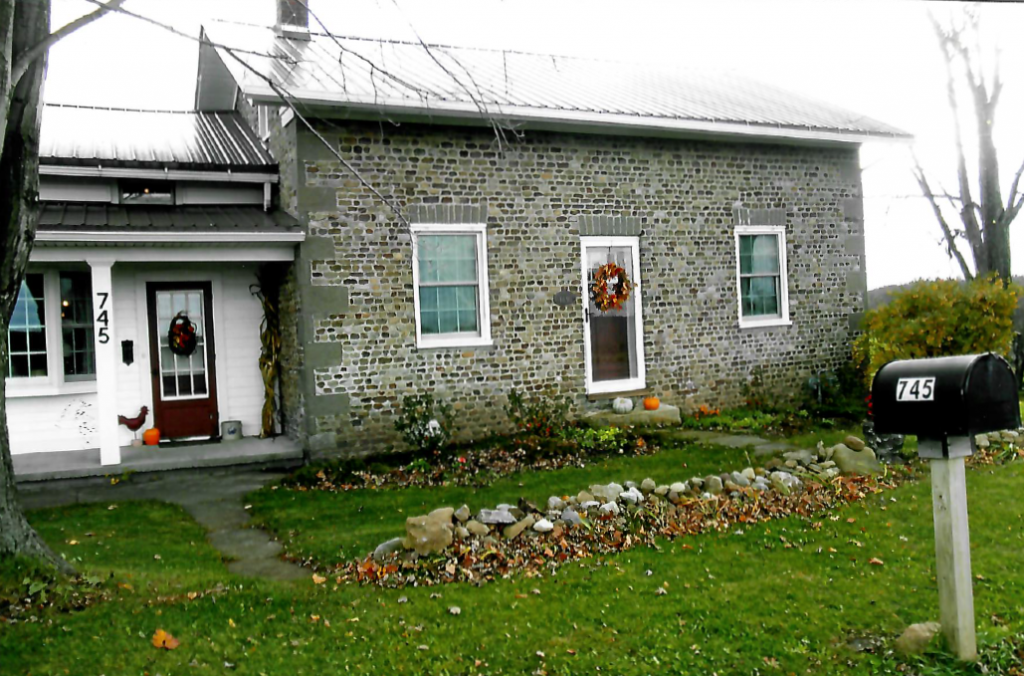
Sometimes The Future Is The Past
745 Ballantyne Road
Standing on the porch of the tidy stout farmhouse on the morning of the season’s first snowfall is always special-the air crisper, cleaner somehow, the sunlight brighter and more welcome, the view of the pastures, the cattle, and even the clucking of the hens a little more revitalizing.
The view alone, atop the hill at 745 Ballantyne Road leaves no doubt as to why, in 1830, David Smith chose the site to build his cobblestone home and why, in 2015, Mary and John Kinton chose to rehabilitate the house and re-purpose its 160 acres.
When Smith broke ground for the family’s four-square cobblestone home Ballantyne Road was no more than a footpath. While the home was being built the Smiths lived in the basement, protected by its substantial rubble-stone walls (sometimes referred to as rag work) that were up to two feet thick. Generally shallow, the basement is 6 feet high with concrete floors and a cistern at floor level. The side hill construction allowed for a walk out exit.
Originally the home featured a center entrance, two rooms on the lower level with a center stairway to its upper level. Additionally, it contained a fireplace with chimneys on both ends of the structure. Its sturdy beams are log and bark and exhibit straight line kerfs on most of the floor joists and beams, their mortice and tenon joints reinforced with wood pegs. The first floor features a large living room, lathe and plaster walls, and an original Lord Rumford fireplace. While most of the trim and molding is original, John did custom cut additional replacement trim with special bits. There are two front door entrances; in keeping with the tradition of in-home wakes the larger of the two was used for funeral services.
Around 1850 the house was enlarged to incorporate a dining room and kitchen; in particular, the woodshed and cistern became the new kitchen and bath-welcome additions to a home that, at times, housed mom, dad, and eleven children. The second floor accommodated three bedrooms and was accessed via a pioneer staircase-steep by modern standards. Finally, in 1890, a frame addition was added that defines the present footprint.
Mary and John purchased the property at public auction in 2015. To say it needed serious rehabbing would be an understatement. The Kintons are to be commended on the toil and hard work that brought this house to its outstanding presentation in just four years. As they stated, the bones were there but virtually everything-from electric to plumbing to roofing-needed updating. Additionally, the flooring, walls, ceilings, and trim required attention. And, of course, the task wasn’t complete without major renovations to kitchen, bath, laundry room and attached porch.
When the Historic Preservation Board considers a property for landmark status, we strive to discover what makes it special-to us but, more importantly, to the owners. What makes this property distinctive is the fact that the Kintons are utilizing-living-the land in much the same way that David Smith did 190 years ago. They raise livestock (registered Black Angus), chickens and turkeys; from a small repurposed shed (now “country store”) they sell brown eggs, pork, Angus beef, local honey and maple syrup. These activities require they maintain their residence and the additional barns, outbuildings and, of course, the land itself. John would probably agree that a herd of cattle requires sturdy fences, good gates, fresh water and ample hay-tons of hay. It is one thing to inhabit an historic building, another, entirely, to embrace an historic way of life within a contemporary lifestyle.
To their credit, the Kintons possess a deep appreciation for their property and the significance, in 2019, of preserving the promise of the property. They welcome learning opportunities, host educational groups, and understand their part in the farm-to-table initiative. What also stands out is their commitment to stewardship, good neighbor relations, and, especially, their acknowledgment that their way of life, their choices are challenges-welcome challenges that they embrace, challenges they chose.
Their biggest payback: The Kintons love what they’re doing; they believe they’re blessed to live the lifestyle they chose, a lifestyle that embraces the land now and as it did in 1830.
Philip Supernault
Chairman, Chili Historic Preservation Board
